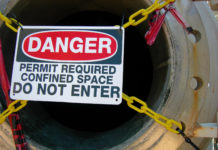Lockout-tagout (LOTO) or lock and tag is a safety procedure which is often used to make sure that harmful machines are properly shut off and are not able to be start up again before the completion of maintenance or repair work.
- A lockout uses a lock to hold an energy isolation device in a safe position and prevents energy to flow to a machine or equipment.
- Tagout is when a tag is placed on a piece of equipment to indicate that the equipment being controlled may not be operated until the tagout device is removed.

OSHA Lockout/Tagout Regulation
The OSHA standard for The Control of Hazardous Energy (Lockout/Tagout), Title 29 Code of Federal Regulations ( CFR ) Part 1910.147, addresses the practices and procedures necessary to disable machinery or equipment, thereby preventing the release of hazardous energy while employees perform servicing and maintenance activities. The standard outlines measures for controlling hazardous energies—electrical, mechanical, hydraulic, pneumatic, chemical, thermal, and other energy sources.
The lockout/tagout standard establishes the employer’s responsibility to protect employees from hazardous energy sources on machines and equipment during service and maintenance.
Hazardous Energy Types
When machines or equipment are being prepared for service or maintenance, the machines or equipment can contain “hazardous energy” that can cause harm to the service or maintenance person and other people in the area.
Hazardous energy, or any type of energy that can be released and might harm a person, can be one of the following types:
- Chemical
- Electrical
- Hydraulic
- Mechanical
- Pneumatic
- Thermal
- Other sources of energy
Six Steps of LOTO Safety & Lockout/Tagout Procedures
A lockout/tagout procedure should include the following six steps:
- Preparation
- Shutdown
- Isolation
- Lockout/tagout
- Stored energy check
- Isolation verification
Types of Lockout/Tagout Devices
There are a range of Lockout/Tagout products, including lockout devices and tagout devices which will secure hazardous energy sources:
- Lockout Cables with Hasps & Locks
- Lockout Group Boxes
- Lockout Kits & Stations
- Lockout Padlocks
- Lockout Plug Devices
- Lockout Tags
- Lockout/Tagout Signs & Posters
Additional Lockout/Tagout Resources
Lockout/Tagout Publications
- Safeguarding Equipment and Protecting Employees from Amputations (OSHA 3170-02R 2007) – Occupational Safety and Health Administration (OSHA)
- Control of Hazardous Energy Lockout/Tagout – OSHA 3120 – 2002 (revised) Occupational Safety and Health Administration (OSHA)
- Guidelines for Controlling Hazardous Energy During Maintenance and Servicing DHHS (NIOSH) Publication No 83-125 – National Institute for Occupational Safety and Health (NIOSH)
- NIOSH Alert: Preventing Worker Deaths from Uncontrolled Release of Electrical, Mechanical , and Other Types of Hazardous Energy DHHS (NIOSH) Publication No 99-110 – National Institute for Occupational Safety and Health (NIOSH)
- Lockout & Tagout – Oregon OSHA’s Guide to Controlling Hazardous Energy The Oregon Department of Consumer and Business Services Occupational Safety and Health Division
- Lockout/Tagout Hazardous Energy Control and Machine Safeguarding Public Education Section – Department of Business and Consumer Business Oregon


















